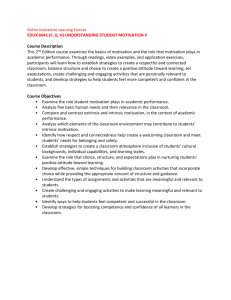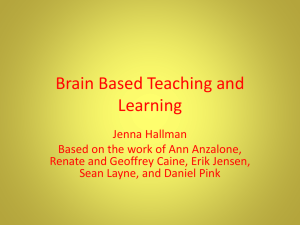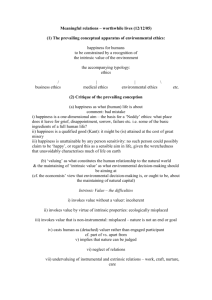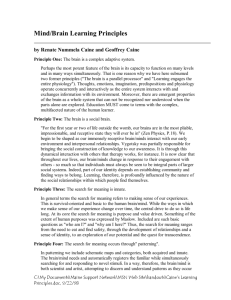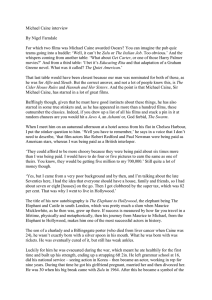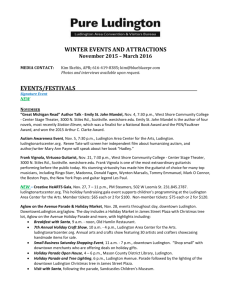Relationship-Driven Teaching
advertisement
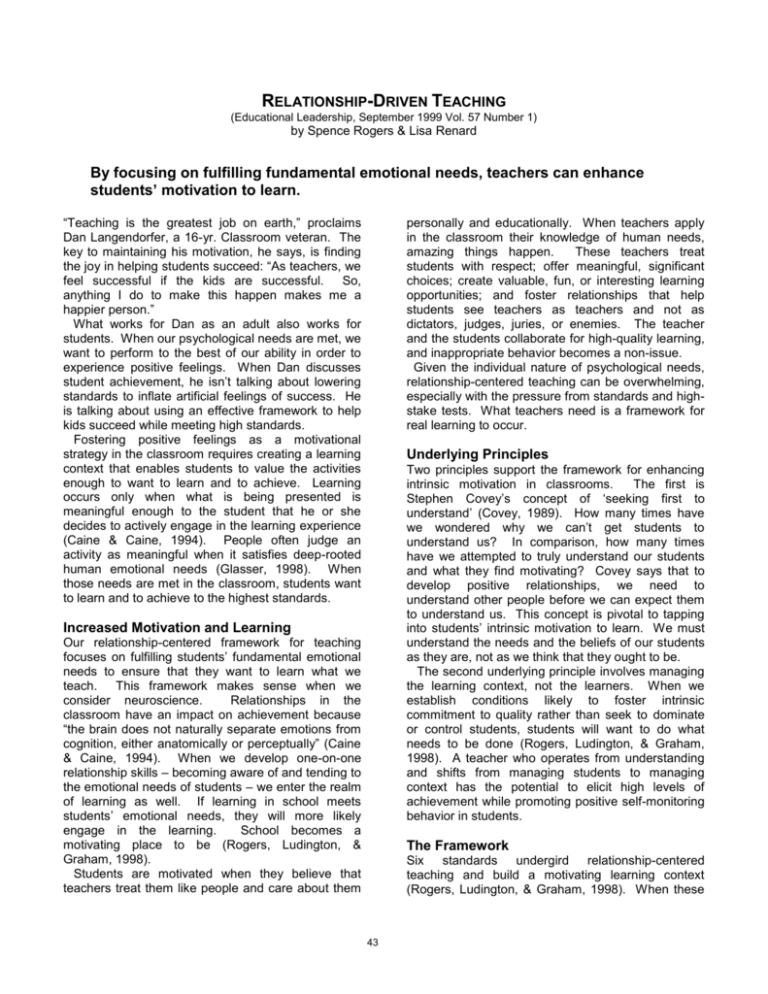
RELATIONSHIP-DRIVEN TEACHING (Educational Leadership, September 1999 Vol. 57 Number 1) by Spence Rogers & Lisa Renard By focusing on fulfilling fundamental emotional needs, teachers can enhance students’ motivation to learn. “Teaching is the greatest job on earth,” proclaims Dan Langendorfer, a 16-yr. Classroom veteran. The key to maintaining his motivation, he says, is finding the joy in helping students succeed: “As teachers, we feel successful if the kids are successful. So, anything I do to make this happen makes me a happier person.” What works for Dan as an adult also works for students. When our psychological needs are met, we want to perform to the best of our ability in order to experience positive feelings. When Dan discusses student achievement, he isn’t talking about lowering standards to inflate artificial feelings of success. He is talking about using an effective framework to help kids succeed while meeting high standards. Fostering positive feelings as a motivational strategy in the classroom requires creating a learning context that enables students to value the activities enough to want to learn and to achieve. Learning occurs only when what is being presented is meaningful enough to the student that he or she decides to actively engage in the learning experience (Caine & Caine, 1994). People often judge an activity as meaningful when it satisfies deep-rooted human emotional needs (Glasser, 1998). When those needs are met in the classroom, students want to learn and to achieve to the highest standards. personally and educationally. When teachers apply in the classroom their knowledge of human needs, amazing things happen. These teachers treat students with respect; offer meaningful, significant choices; create valuable, fun, or interesting learning opportunities; and foster relationships that help students see teachers as teachers and not as dictators, judges, juries, or enemies. The teacher and the students collaborate for high-quality learning, and inappropriate behavior becomes a non-issue. Given the individual nature of psychological needs, relationship-centered teaching can be overwhelming, especially with the pressure from standards and highstake tests. What teachers need is a framework for real learning to occur. Underlying Principles Two principles support the framework for enhancing intrinsic motivation in classrooms. The first is Stephen Covey’s concept of ‘seeking first to understand’ (Covey, 1989). How many times have we wondered why we can’t get students to understand us? In comparison, how many times have we attempted to truly understand our students and what they find motivating? Covey says that to develop positive relationships, we need to understand other people before we can expect them to understand us. This concept is pivotal to tapping into students’ intrinsic motivation to learn. We must understand the needs and the beliefs of our students as they are, not as we think that they ought to be. The second underlying principle involves managing the learning context, not the learners. When we establish conditions likely to foster intrinsic commitment to quality rather than seek to dominate or control students, students will want to do what needs to be done (Rogers, Ludington, & Graham, 1998). A teacher who operates from understanding and shifts from managing students to managing context has the potential to elicit high levels of achievement while promoting positive self-monitoring behavior in students. Increased Motivation and Learning Our relationship-centered framework for teaching focuses on fulfilling students’ fundamental emotional needs to ensure that they want to learn what we teach. This framework makes sense when we consider neuroscience. Relationships in the classroom have an impact on achievement because “the brain does not naturally separate emotions from cognition, either anatomically or perceptually” (Caine & Caine, 1994). When we develop one-on-one relationship skills – becoming aware of and tending to the emotional needs of students – we enter the realm of learning as well. If learning in school meets students’ emotional needs, they will more likely engage in the learning. School becomes a motivating place to be (Rogers, Ludington, & Graham, 1998). Students are motivated when they believe that teachers treat them like people and care about them The Framework Six standards undergird relationship-centered teaching and build a motivating learning context (Rogers, Ludington, & Graham, 1998). When these 43 standards are met, students’ core needs are met. Students want to learn, and they self-monitor their behavior. When teachers apply in the classroom their knowledge of human needs, amazing things happen! Brainstorm ways to make learning the content pleasant and unique. Find an audience for the students’ efforts. Give them opportunities to publish their writing, perform before another class, present work to parents in student-lead conferences, share thinking with partners or groups, and post work in and around the school. Standard 3: Successful. To maintain intrinsic motivation, students need evidence of success in achieving either mastery or significant progress toward mastery. Make learning activities challenging for each student and give regular and meaningful evidence of progress. For example, students could chart their progress; use learning logs to reflect on what they can do now but couldn’t do before the lesson; or post goals at the beginning of a unit, review those goals periodically to monitor success, and set new goals when the first are accomplished. Mastery learning, an idea formalized by Benjamin Bloom, James Block and Thomas Guskey, lends itself well to meeting this standard. Though mastery learning has come under criticism when associated with inappropriate or ineffective implementation, the underlying theory of teaching and reteaching until students master a concept can powerfully affect students’ perceptions of success. Another success booster is a growth portfolio, which necessitates that students track their own progress. Standard 1: Safe. For students to place a priority on learning, they must feel safe from both physical danger and embarrassment. Fear of physical harm and fear of embarrassment often have the same effect. Students should not have to worry that a lack of skills or knowledge or an embarrassing fact about their private lives might be exposed. Eric Jensen (1998) affirms the brain-compatible necessity of this standard by stating that learning depends on “removing threat.” But more important, teachers must actively create conditions for students to feel safe, such as eliminating all sarcasm and any perceptions of put-downs in the classroom. What the teacher may intend as innocent fun, a student could easily perceive as hurtful, unnecessary, and inappropriate criticism. It is essential to ensure that students believe that taking learning risks is acceptable. We teachers don’t penalize ourselves for trying varying approaches to teaching, nor do we let ourselves off the hook when our ideas fail – we simply reteach until we are successful. Feeling safe with learning risks is important for students and their motivation. Rather than excuse or punish their less-than-successful efforts, we can hold students accountable for the quality of their work while promoting innovation. Using a “dress rehearsal” concept for setting due dates encourages students to take learning risks. If a student’s work is high quality at the dress rehearsal date, he or she has no further obligation. Otherwise, the student continues to refine the work with the teacher’s support until the final due date. Standard 4: Involving. Students are more motivated to learn when they have a meaningful stake in what’s going on. They want to contribute and to participate if they have helped plan, administer, and make meaningful decisions about what and how they are learning. The involvement standard asks that we give students meaningful choices in connection with content, instructional methods, assessment, and evaluation. PEngage students in creating the rubrics for guiding, assessing, or evaluating their work because the process of developing a good rubric is more important than the rubric itself. Give students options for demonstrating what they have learned or even for what color ink they use. In many classrooms, teachers ask students to devise the daily writing journal topics, which provides involvement and increases the value of the topics to the students. In other classrooms, students help ascertain their own rights and responsibilities as well as those of the teacher. Standard 5: Caring. Students respond positively to being liked and to being accepted and respected members of the class. Everyone has a basic need for love and belonging; students are no exception. They want to feel valued and cared about. They want to be part of the group rather than outsiders. Learning occurs only when what is being presented is meaningful. Standard 2: Valuable. Students are more apt to engage fully and produce quality work if they perceive that when they are doing has value. That is, it must fill a need; solve a problem; or be interesting, fun, or enjoyable. Several strategies help students feel that the classroom is a valuable place to be: Ask students to find and share ways that the content is used outside of school. Embed content in activities that students find personally interesting and, if possible, that are also outside-of-school, real-world applications. 44 Teachers send “I care about you” signals when they meet students with a smile or use inviting language, such as “I would like us to” instead of “you need to.” Teachers tell students that they care when they listen sincerely and value every response, even when it is not what they expected or desired. Teachers tell students that they care when they show that they want everyone to succeed by making a commitment to enabling students to do so. Simply using students’ names correctly on the first day of school sends a powerful “you count to me” message. In a caring classroom, relationships based on shared respect, trust, and high expectations are nurtured among every person in the classroom. needs of learners and to promote intrinsic motivation. Creating a motivating environment requires an abundant supply of brain-compatible, researchbased strategies and techniques. Because each student comes fully equipped with a core set of emotional needs, teachers who recognize and focus on meeting those needs while teaching content build classroom environments in which the students’ intrinsic motivations to learn and to succeed are the driving forces for learning excellence. The six standards and two underlying principles offer a powerful framework to create those environments and to help students want to learn what we teach. References Caine, G., & Caine, R. (1994). Making connections: Teaching and the Human Brain. New York: Addison-Wesley. Standard 6: Enabling. To create a motivating context, teachers must constantly seek our best practices that enable students’ learning and ensure students’ attainment of standards. Braincompatible, research-supported teaching techniques allow students to move around the classroom, address multiple modes of learning, acknowledge outlets for creative presentation of learning, provide enough contrast to preclude boredom, and contribute to a motivating context. Covey, S. (1989). Choice Theory: A New Psychology of Human Freedom. New York: HarperPerennial. Jensen, E. (1998). Teaching with the Brain in Mind. Alexandria, VA: ASCD. We must understand the needs and beliefs of our students as they are, not as we think they ought to be. Rogers, S., Ludington, J., & Graham, S. (1998). Motivation and Learning. Evergreen, CO: Peak Learning Systems. Teachers who enable learning make it their business to understand how the brain takes in, processes, and uses information. They master strategies and techniques known to aid learning for all students instead of relying on methods they have always used. These teachers employ summarization; provide anticipatory and closure strategies; and ensure a tight alignment among curriculum, instruction, and assessment. They are not afraid to use new, theoretically sound teaching practices when what they’ve been doing has not led to mastery by all students. Spence Rogers is Director of Peak Learning Systems, 6784 South Olympus Drive, Evergreen, CO 80439 (e-mail: Peaklearn@aol.com) Lisa Renard is an English teacher who maintains the New Teacher Page at www.new-teacher.com (e-mail: renard@newteacher.com). Interconnected Standards A spider’s web is strong and beautiful – a work of art. Using the six standards in our classrooms creates a web that is just as intricate and just as strong. The standards cannot be applied separately. They cannot be considered disconnected ideas. They cannot be applied in a step-by-step, linear manner. Rather, the six standards interact simultaneously to balance the 45

